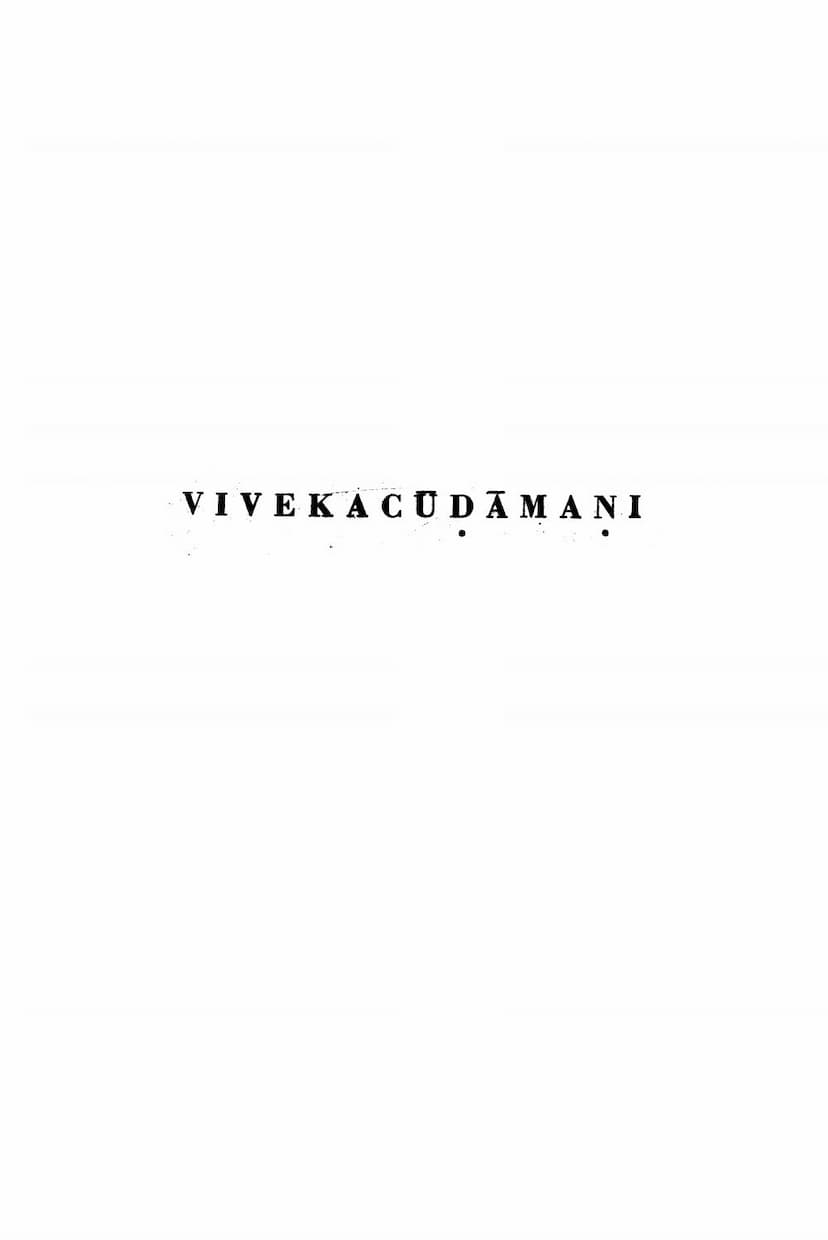Vivek Chudamani
Added to library: September 2, 2025

Summary
The text you provided is the English translation of the Sanskrit preface and introduction to Vivekacūḍāmaṇi, a philosophical treatise attributed to Adi Shankaracharya. The book itself is Vivekacūḍāmaṇi of Sri Samkara Bhagavatpada, with an English translation of the commentary in Sanskrit by Jagadguru Sri Chandrasekhara Bharati Svaminah.
Here's a comprehensive summary based on the provided text:
Book Title: Vivekacūḍāmaṇi Author(s): Sri Samkara Bhagavatpada (Original Text), Jagadguru Śri Candrasekhara Bhāratī Svāminah (Commentary in Sanskrit), P. Sankaranarayan (English Translation) Publisher: Bharatiya Vidya Bhavan Core Subject: Advaita Vedanta, specifically the path to liberation (moksha) through knowledge (jnana) and discrimination (viveka).
Summary of the Text's Content and Purpose:
The text is a profound exposition of Advaita Vedanta, a school of Hindu philosophy that posits the oneness of the individual soul (Atman) and the Supreme Reality (Brahman). The Vivekacūḍāmaṇi, meaning "Crest Jewel of Discrimination," aims to guide aspiring individuals towards realizing their true nature and achieving liberation from the cycle of birth and death (samsara).
Key Themes and Concepts:
-
The Importance of the Human Birth: The preface and introduction strongly emphasize the rarity and preciousness of human birth, particularly as a qualified individual (like a Brahmana), highlighting it as the opportune moment for spiritual quest and the pursuit of liberation.
-
The Ultimate Goal: Moksha (Liberation): The ultimate aim is moksha, a state of freedom from the cycle of birth, death, suffering, and ignorance (avidya). This is achieved through jnana, the realization of the non-dual nature of reality.
-
The Path of Viveka and Vairagya: The core of the teaching revolves around discrimination (viveka) between the eternal (Atman) and the transient (anātman) and detachment (vairagya) from worldly pleasures and pursuits. These are presented as essential prerequisites for spiritual progress.
-
The Role of the Guru: The text underscores the indispensable role of a qualified Guru (sadguru) in guiding the disciple on the path of Advaita Vedanta. The disciple must approach the Guru with humility, devotion, and earnestness to receive instruction and dispel doubts.
-
Analysis of the Koshas (Sheaths): A significant portion of the text is dedicated to analyzing the five koshas (sheaths) that cover the Atman:
- Annamaya Kosha: The gross physical body, composed of food and subject to birth, death, and decay.
- Prāṇamaya Kosha: The vital body, composed of vital airs (prāņas), responsible for bodily functions.
- Manomaya Kosha: The mental body, comprising the mind, senses, and thoughts, responsible for desires and imaginations.
- Vijñānamaya Kosha: The intellectual body, the instrument of determination and action, often mistaken for the self.
- Ānandamaya Kosha: The blissful sheath, a reflection of Brahman's bliss, but still considered a modification and thus not the ultimate Reality.
-
The Nature of Atman and Brahman: Through the process of negation (neti neti), the text reveals the Atman as the pure, unchanging, self-effulgent, infinite, and non-dual reality (Brahman) that underlies all existence, untouched by the modifications of the mind and the limitations of the body.
-
The Doctrine of Mithyā: The world of phenomenal appearance, including the physical and subtle bodies, is described as mithya – not absolutely real (sat) because it is sublated by knowledge, nor absolutely unreal (asat) because it appears. It is like a mirage or a rope mistaken for a serpent.
-
The Means to Realisation: The text advocates for śravana (hearing), manana (reflection), and nididhyāsana (deep meditation) as the primary means to realize the identity of the Atman and Brahman.
-
The State of Jīvanmukti: The ultimate goal is jivanmukti – liberation while still living in the body. This is described as a state of complete freedom from bondage, suffering, and the cycle of rebirth, characterized by eternal peace, bliss, and the realization of one's true nature as Brahman. A jivanmukta is depicted as equanimous, indifferent to worldly matters, and living in the bliss of the Atman.
-
Overcoming Obstacles: The text addresses common obstacles such as the ego (ahamkara), desires (vasanas), and negligence (pramada), and provides guidance on how to overcome them through persistent effort, detachment, and wisdom.
Commentary's Significance:
The commentary by Jagadguru Śrī Candrasekhara Bhāratī is highly praised for its clarity, depth, and authoritative nature. It is noted for drawing extensively from source texts of Advaita Vedanta, elucidating nuances, and drawing upon the commentator's own profound spiritual realization, making the complex philosophical concepts accessible and convincing.
Overall Purpose:
The Vivekacūḍāmaṇi, through its systematic analysis and profound commentary, aims to illuminate the difficult path of self-realization according to Advaita Vedanta, guiding the earnest seeker to discriminate between the Real and the unreal, ultimately leading to the direct experience and realization of their true, non-dual nature as Brahman.